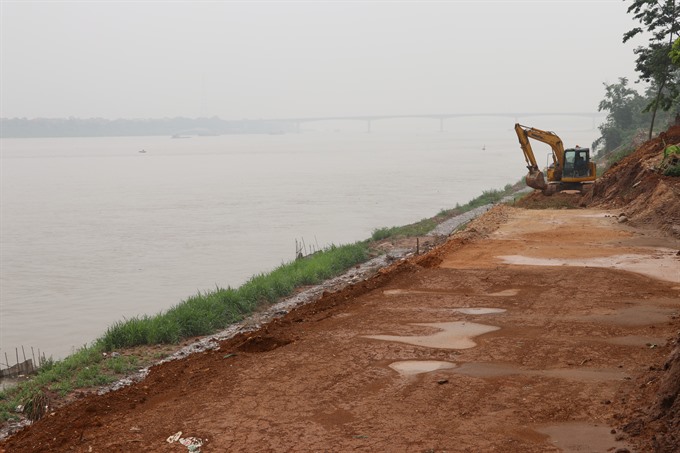 Society
Society

Amid the peak of the rainy season, dyke violations in Hà Nội are set to rear their ugly head.
 |
| A damaged section of Hồng (Red) River’s dyke running through Thường Tín District in Hà Nội is repaired by a competent agency. - VNA/VNS Photo Mạnh Khánh |
HÀ NỘI – Amid the peak of the rainy season, dyke violations in Hà Nội are set to rear their ugly head.
Violations have existed for many years but have not been resolved by competent agencies, harming dyke safety, the flood irrigation corridor for the capital.
According to Nhân Dân (The People) newspaper, most of the dyke violations involved the construction of houses and workshops, illegal sand exploitation, storage of building materials and overloaded vehicles travelling on dykes.
Other violations included dumping construction rubbish, removing gravel and digging irrigation channels.
The violations occurred frequently on the Hồng (Red) River section running through Thường Tín District.
About seven building material storage points licensed by local agencies were found in Thống Nhất Commune with dozens of high sand piles along the river’s dyke, the report said.
Along the river’s dyke in Liên Mạc Ward of Bắc Từ Liêm District, seven companies occupy unused land to store and transport construction materials, with sand piled up behind trees.
These points are located near the river, about 100m from the dyke, causing damage and subsidence to the dyke, with overloaded trucks operating all day and night.
Nguyễn Hữu Đắc, a resident in Thường Tín District’s Hồng Vân Commune, said these vehicles had not only threatened the safety of the dyke but also polluted the environment and affected the lives of thousands of households.
Households in Ninh Sở Commune have also blamed owners of building material storage sites for encroachment on agricultural land and dyke protection corridors to build workshops, damaging the dyke in the rainy season.
Many violations have been tackled by local authorities but offenders still ignore the regulations and sanctions and have continued violating for years.
Widespread violations are reducing the dykes’ effectiveness in the storm season, yet little has been done to resolve the issue.
Đỗ Đức Thịnh, head of Dyke Management and Flood Prevention Division, said the capital city’s dyke system was in good shape to control floods. However, with the unusual occurrence of natural disasters, it was difficult to anticipate incidents.
Serious violations were being reported, such as the presence of houses and other constructions on the dykes, but they had not resulted in a clearance of the dykes, he said.
Statistics showed there were 15 violations in 2015 and 47 in 2016.
In 2017, heavy rain washed away a section of the dyke on Bùi River in Chương Mỹ District, causing serious damage to local property.
More than 1,000 households of the two communes were isolated by floods and hundreds of hectares of crops, aquatic products and cattle were destroyed.
According to the city’s Department of Agriculture and Rural Development, some landslides occurred on embankments in Ba Vì and Phúc Thọ districts since the beginning of this year, threatening the dyke system, lives and property.
Chu Phú Mỹ, the department’s director, said thousands of dyke violations had occurred.
In April alone, 22 violations were reported in Hà Nội.
Mỹ said many people claimed they did not know their actions had violated the dyke protection corridor.
It seemed that people were not informed about dyke laws, he said.
Vice chairman of Ninh Sở Commune People’s Committee, Đỗ Cao Mạnh, said in addition to the limited knowledge of the people, another issue was that the Dyke Law and legal documents had revealed inadequacies after more than 10 years of implementation.
There were still unspecific regulations on violations, causing difficulties to agencies, he said.
Lê Xuân Tiến, inspector of Hà Nội Department of Transport, said a lack of strict punishment on the violations made the situation complicated.
The department would continue to work with local authorities to review and add more traffic signs and vehicle weight restriction signs along the dyke, he said.
The inspection should also be strengthened in terms of compliance with the regulations of the transport companies, especially those with multiple offences to improve the situation, said Tiến. — VNS




